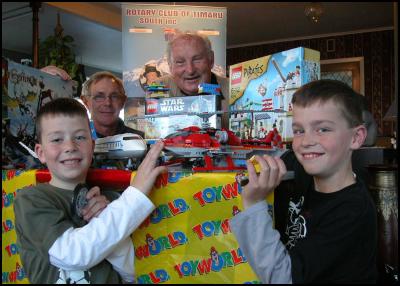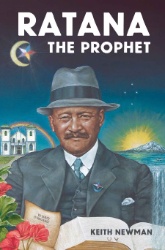Lego Olympics will test imaginations
Lego Olympics will test the imagination of Timaru
children – and their dads

Notice how
much quieter households have become lately?
But for a faint clicking sound, a silence has descended among hundreds of primary school pupils around South Canterbury who are looking more absorbed than usual. That’s because creatures, objects and weird and wonderful creations are being conceived behind those blank stares.
And the reason?
The Lego Olympics are returning to Timaru.
Pioneered as a New Zealand first last year by Rotary Timaru South, the Lego Olympics have captured the imagination of hundreds of young people countrywide. They have flocked to Rotary-run Lego building competitions to pit their skills against each other in building models to a pre-determined design and in anything-goes sections.
Assistant district governor of Timaru’s four Rotary clubs Don George said Rotary was excited about bringing the Lego contest back to South Canterbury.
“Rotary is well known for its commitment to young people with the various exchanges we run nationally, the science school programme where we send selected secondary school students to Dunedin for science-based study, and workplace placement schemes.
“Rotary South has done an excellent job of nationally launching and running this mind-teasing and rewarding contest and I commend all of our young people to use their imaginations and have a go.”
Mr George, who will also be officiating as chief judge, said Rotary thanked the sponsors of this year’s event, Lego NZ, Toyworld and Mitre 10.
The success and competitive spirit within the contest last year was noticed by Rotary Timaru South’s Lego contest originator Stuart Croft of Timaru.
But Mr Croft also noticed something else. It was not just the kids having a whale of a time. Dads were asking “what about us?”
So to cater for the unexpected burst of enthusiasm from parents and secondary school students, this year’s Lego Olympics, to be held at Bluestone School hall on July 8 and 9, will feature an evening Lego building contest just for them.
And Mr Croft said there would be another important difference too – the two day contest and static display would move from a weekend fixture into a mid-week Wednesday and Thursday slot during the school holidays, just to ensure all pupils got the chance to enter. The adults’ event would be held on the Wednesday night.
“We found that holding it over a weekend last year meant sport commitments prevented many pupils from participating.
“They were bitterly disappointed so this year, mid-week means everyone can have a go.”
Mr Croft said the Lego Olympics was a Rotary Timaru South project for the community “to thank them for their support in the many other projects we run each year”.
He said the rules would be the same as last year.
Schools could enter teams of three in each age group – junior, Year 3 and 4; middle, Year 5 and 6; and senior, Year 7 and 8. The maximum number of teams in each level would be 32. Schools could have more than one team in each level but total numbers were limited to 32.
“The goal will be for each team to build a model in a given time, probably about 10 minutes. A topic or theme would be drawn just before each heat and judged at the end of the allotted time.” Mr Croft said.
Examples of themes included bridges, rockets, and robots, he said.
“Four teams will compete in each heat with winning teams going through to the next round.”
And there could be no cheating with pre-built structures or intricate pieces of the plastic blocks smuggled into the Bluestone School Hall in pockets or lunch boxes.
“Each team would have an identical bucket of Lego supplied by Lego New Zealand to work with and each heat would have a different topic or theme,” Mr Croft said.
Mums and dads would work individually. They will have to build a Mitre-10 product such as a skilsaw or an electric drill, but won’t know what their task is until a few minutes before the starting gun, he said.
An individual static display competition would also be held.
Mr Croft said that in this section children could make models at home or school and enter in the same three age groups as the Olympics.
“These models will be displayed over the two days and judged during this time. The winner would be announced after the Olympic finals on the second day,” he said.
Lego consists of colorful interlocking plastic bricks and an accompanying array of gears, and various other parts. They were originally designed in the 1940s in Europe and have achieved an international appeal among kindergarten toddlers, schoolchildren, teenagers and young-at-heart adults.
Readers interested in finding out more about the Lego Olympics can contact Mr Croft on (03) 688 4250.
ENDS


 Keith Newman: Revised Edition Of Ratana Biography Highlights Lasting Legacy
Keith Newman: Revised Edition Of Ratana Biography Highlights Lasting Legacy Environmental Defence Society: Groundhog Day, New Book Shows History Is Repeating Itself
Environmental Defence Society: Groundhog Day, New Book Shows History Is Repeating Itself NZEI Te Riu Roa: Mandated Single Approach To Reading Will Not Work
NZEI Te Riu Roa: Mandated Single Approach To Reading Will Not Work The Conversation: Could The School Phone Ban Work?
The Conversation: Could The School Phone Ban Work? Public Health Communication Centre: To Avoid A Measles Epidemic, Aotearoa Must Close The ‘Immunity Gap’
Public Health Communication Centre: To Avoid A Measles Epidemic, Aotearoa Must Close The ‘Immunity Gap’ Heritage New Zealand: Kid-friendly Archaeology Resource Kit Launched As Part Of Archaeology Week
Heritage New Zealand: Kid-friendly Archaeology Resource Kit Launched As Part Of Archaeology Week